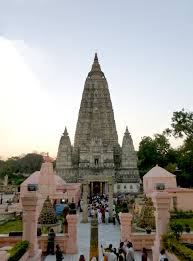History of Mahabodhi Temple – The Enlightenment Site of Buddha

Nestled in the sacred town of Bodh Gaya in Bihar, India, the Mahabodhi Temple stands as one of the most revered pilgrimage sites for Buddhists around the world. It marks the very spot where Siddhartha Gautama attained enlightenment and became the Buddha, nearly 2,500 years ago. The Mahabodhi Temple isn’t just a symbol of peace and wisdom; it is also a stunning example of ancient Indian architecture and a UNESCO World Heritage Site.
The Legend of Enlightenment
The journey of the Mahabodhi Temple begins with a young prince named Siddhartha Gautama. Renouncing his luxurious life in pursuit of truth, he wandered through forests, meditated for years, and finally arrived at Uruvela (modern-day Bodh Gaya). Here, under the sacred Bodhi Tree, Siddhartha meditated deeply until he achieved Supreme Enlightenment, thus becoming the Buddha – “The Awakened One”.
This profound moment in human spiritual history happened over 2,500 years ago, and the site has since attracted seekers, pilgrims, monks, and scholars from across the globe.
Origin and Construction of the Mahabodhi Temple
The first temple at the site is believed to have been built by Emperor Ashoka in the 3rd century BCE. A devout follower of Buddhism, Ashoka visited Bodh Gaya and is said to have constructed a diamond throne (Vajrasana) to mark the sacred spot where Buddha meditated.
The current structure, however, dates back to the 5th–6th century CE, built using bricks, which makes it one of the oldest surviving brick structures in India. The temple has undergone several restorations over the centuries, especially during the Gupta period, which is evident in its intricate carvings and detailed sculptures.
Architectural Marvel
The Mahabodhi Temple is a towering structure standing at about 55 meters high, designed in the shape of a pyramidal spire with a lotus-shaped finial at the top. The temple is surrounded by smaller stupas and shrines, many of which date back centuries. At its core lies the sanctum sanctorum housing a large gilded image of Buddha in the Bhumisparsha mudra (Earth-touching posture), symbolizing the moment of his enlightenment.
The Bodhi Tree, a direct descendant of the original, still grows beside the temple and is a major site of prayer and meditation for devotees.
UNESCO World Heritage Site
In 2002, the Mahabodhi Temple Complex was recognized as a UNESCO World Heritage Site, acknowledging its unparalleled spiritual and cultural significance. It is not just a monument but a living heritage site, continuously used for worship, meditation, and teachings, attracting visitors from all faiths and backgrounds.
Global Pilgrimage Hub
The Mahabodhi Temple attracts millions of pilgrims and tourists every year from all over the world—especially from countries with strong Buddhist traditions such as Sri Lanka, Thailand, Japan, China, Myanmar, Bhutan, and Nepal. Many international monasteries have also been built around Bodh Gaya, reflecting various Buddhist architectural styles and practices.
The Spirit of Mahabodhi Today
Today, the Mahabodhi Temple stands not only as a historical monument but as a symbol of peace, compassion, and enlightenment. It inspires millions to seek inner peace through meditation, reflection, and the teachings of the Buddha.
Whether you're a devout Buddhist, a history enthusiast, or a spiritual seeker, visiting the Mahabodhi Temple offers a deeply moving and transformative experience.
Plan Your Spiritual Journey with the Best – See City Destination Pvt. Ltd.
If you’re planning to visit Bodh Gaya and explore the divine trail of Lord Buddha, look no further than See City Destination Pvt. Ltd., the best travel agency in India. With expert guides, customized tour packages, and a deep understanding of spiritual travel, See City Destination ensures a comfortable and enriching experience for every traveler. Let them help you trace the footsteps of the Enlightened One with convenience and care.
How can I help you?

 Hurry! Fill Form & Get Best Deals
Hurry! Fill Form & Get Best Deals